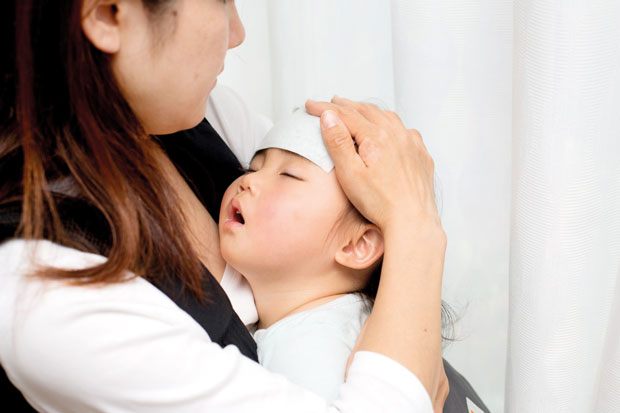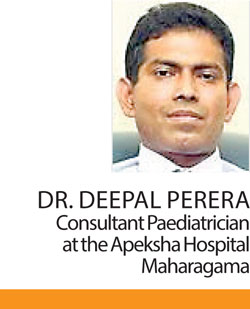05 Jan 2018 - {{hitsCtrl.values.hits}}

 Most parents are familiar with the term ‘febrile seizures’ or fever fits, where young children suddenly develop seizures following fever. Due to the alarming presentation of the condition, these fits could be very distressing from the perspective of parents.
Most parents are familiar with the term ‘febrile seizures’ or fever fits, where young children suddenly develop seizures following fever. Due to the alarming presentation of the condition, these fits could be very distressing from the perspective of parents.
There are many controversies surrounding febrile fits, as well as the ‘need to know’ by the parents in case their child develops this condition. The Health Capsule consulted Dr. Deepal Perera, Consultant Paediatrician at the Apeksha Hospital Maharagama, to obtain more details on the topic. During a febrile fit, an otherwise normal child- who has had a high temperature- suddenly starts convulsing. It may start with the child suddenly going tense and this condition will be followed by the arms and legs becoming twitchy. The child losses consciousness, usually for a very short duration; less than 5 minutes being common, with no lasting effects.
Who will develop this condition?
“Almost all the children who get febrile fits are between 6 months to 6 years of age,” states Dr. Perera. Children of parents, who have had febrile fits in childhood, have a high risk of developing this condition.
Seizures 
Febrile fits are categorized into two groups, according to Dr. Perera. Simple febrile fits, where the fit is spread around the whole body, is called ‘generalized seizures’. This condition doesn’t last for more than 15 minutes.
A child is said to have complex seizures if he has more than one fit within a short duration of time, or the fit lasts for more than fifteen minutes and if the convulsion is limited to one part of the body only, like an arm or a leg. More investigations need to be done with regard to treating of
complex seizures.
Challenges during treatment
The major challenge in managing these patients is the exclusion of meningitis as a diagnosis, according to the doctor. “Infants and children with meningitis also usually present with fits following fever. With regard to these patients we will have to check for other signs present in meningitis, because unlike febrile fits, meningitis is a serious condition and demands urgent treatment,” explains Dr. Perera. The children who have meningitis may also present with vomiting, headache, neck stiffness, confusion and in case of infants, bulging in the anterior part of the head, where the skull bones have not fused properly. In these cases, more investigations like lumbar puncture need to be done and a course of antibiotics must be
administered immediately.
How to manage this condition
If the condition is diagnosed as febrile fits, the ‘wait and watch’ approach is preferred, rather than starting anti- convulsive drugs immediately. Paracetamol is prescribed according to the child’s age and weight, and if the fever is high, tepid sponging is done with lukewarm water.
But why not start on other drugs?. He explains that drugs should be used with extreme caution during childhood because the side effects of the medicine can be severe regarding small children. So before starting on a drug the risk to benefit ratio should always be assessed. “Febrile fits are very innocent in most cases and will disappear on it’s own. The drugs used for treatment, on the other hand, can produce side effects like hyperactivity and liver damage in children, hence they are rarely prescribed, unless during special circumstances”, he explains.
Recurrence
According to the doctor, most children who develop febrile fits only get them once or twice in their lives. But there may be other children who may get it even 7/ 8 times. He assures parents that there is little cause for worry as long as the child doesn’t get more than one fit per one attack of fever and they do not last past 6 years of age.
Long-term effects
Dr. Perera stresses that there is very little or no impact on the child in the future due to this condition. “The chance of these seizures developing into epilepsy- that is recurrent seizure attacks in adulthood- are almost none,” he reassures. He further added that these attacks will not be present once the child is past age six. These attacks will not affect a child’s growth or the development of the brain in anyway, he concluded. So, with the majority of patients, the condition known as febrile attack is innocent, appearing only during a certain age group in children and vanishing on its own, leaving no after effects. But this doesn’t mean that the parents do not have to be vigilant. If your child has had fever in the past, take extra caution during a fever and give him the prescribed dose of Paracetamol to get the temperature to lower. There are some important points that the bystander should follow if a child is having a fit, because, how you act during the time may have a lasting effect on the child’s health. The traditional belief that a stick or a spoon should be put into the mouth during a seizure is misplaced and should be discouraged. The child should not be fed anything during an attack since this might cause aspiration and might even cause brain damage.
The do’s and don’ts
Turn the child into his or her left side to the position called the ‘left lateral position’, to minimize the chance of aspiration. Refrain from putting anything into the child’s mouth during an attack. Do not raise the child’s head, as this again increases the risk of aspiration and may prove fatal to the child.
Time the seizure attack and if it lasts more than five minutes, take the child to the nearest hospital, disturbing his position as little as possible.
23 Dec 2024 18 minute ago
23 Dec 2024 23 minute ago
23 Dec 2024 1 hours ago
23 Dec 2024 2 hours ago
23 Dec 2024 2 hours ago